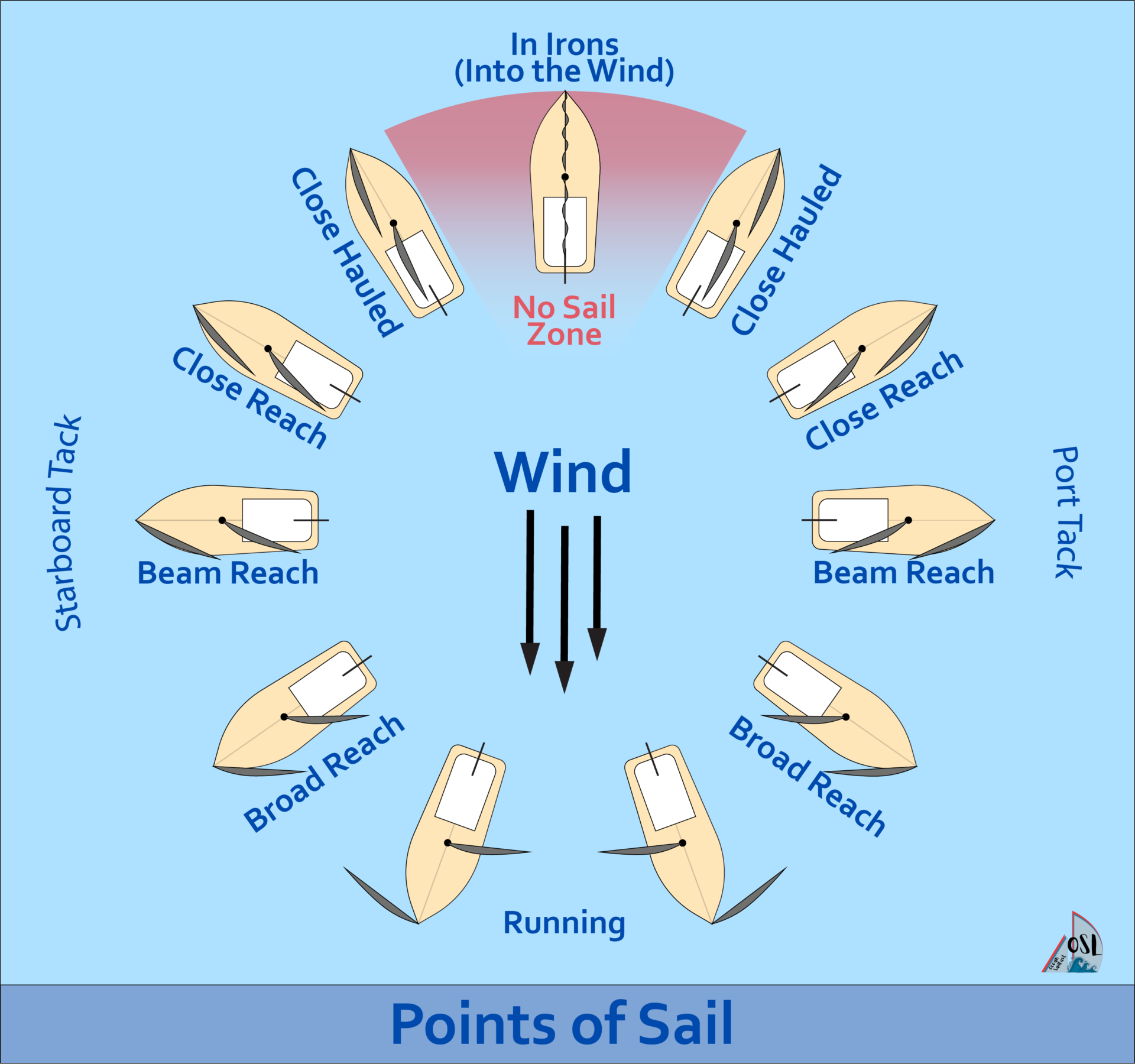The 6 Points of Sail: Diagram of Wind Direction and Sail Trim
Points of sail are the different angles at which a sailboat can sail in relation to the wind. Understanding these points is crucial for anyone who wants to learn how to sail, and it’s usually taught in sailing schools. Each point has its own characteristics that determine the boat’s speed and direction.
The main points of sail are:
- Into the wind: The no-sail zone
- Close-hauled: Sailing as close to the wind direction as possible.
- Close reach: Sailing between a beam reach and close-hauled, at an angle to the wind.
- Beam reach: Sailing perpendicular to the wind, with the wind hitting the side of the sail.
- Broad reach: Sailing with the wind coming from behind at an angle.
- Running: Sailing directly downwind, with the wind coming from behind.
Understanding how to navigate through each point of sail effectively takes practice and patience. It’s important to know your boat’s capabilities and limitations so you can adjust your technique accordingly.
Points of Sail
To comprehend the points of sail, it is essential to grasp the relationship between a sailboat’s trajectory and the direction of the true wind. The points of sail encompass a full 360-degree circle, each segment representing a distinct sailing direction.

1. In Irons (Into the Wind)
Embarking on our journey, we encounter the point of sail known as “into the wind” or “in irons.” This position aligns your sailboat directly into the wind, within a range of plus or minus 45 degrees from 0 degrees. While this point of sail hinders forward progress, it serves as a pivotal moment for executing various sailing maneuvers, such as tacking and mast adjustments.
Tacking involves transitioning from one side of the wind to the other, crossing the into the wind point of sail. It is crucial to navigate this maneuver swiftly, as prolonged exposure in this “no-go zone” can impede momentum. Should you fail to traverse this point expediently and become stuck, it is referred to as being “taken aback.”
2. Close Hauled
Advancing beyond the into the wind point of sail, we arrive at the close hauled position. Sailing close hauled refers to navigating upwind, moving toward the wind’s direction. This point of sail, often referred to as “beating” or “working windward,” offers an intimate connection with the wind, enriching your experience as both captain and crew member.
During close hauled sailing, your sail assumes the role of an airplane wing, cutting through the wind head-on and generating optimal lift. Precise sail trim is paramount in this configuration, with tighter adjustments maximizing the sailboat’s ability to “point” towards the wind and optimize performance.
3. Close Reach
Continuing our voyage, we transition from close hauled to the close reach point of sail. Positioned between close hauled and beam reach, this segment represents a thrilling and rapid sailing direction. Sailors often revel in the exhilaration offered by the close reach point of sail.
Close reach resides closest to the “no-go zone” compared to other points of sail. It’s important to pay close attention to the wind and how the sails are set when sailing close reach. The sail needs to be tight, like when sailing close hauled, but loose enough so it’s just not luffing. This will help the boat sail efficiently when sailing upwind.
4. Beam Reach
As our sailboat maneuvers further away from the wind’s direction, we arrive at the beam reach point of sail. In this configuration, the sailboat is perpendicular to the wind, either on the starboard or port side. Notably, the beam reach point of sail boasts both speed and comfort, making it a preferred choice among sailors.
At beam reach, your sails are partially let out, the wind’s interaction with the sails in this position optimizes energy transfer from the lateral force to forward propulsion. The result is a harmonious conversion of wind power into the sailboat’s forward motion, ensuring an exhilarating and controlled sailing experience.
5. Broad Reach
Progressing from the beam reach, we venture into the realm of the broad reach point of sail. As we veer further downwind, the sails are let out approximately two-thirds of their capacity. At this stage, the wind doesn’t approache directly from astern but at an angle. As a consequence, the sail begins to function more like a parachute, relying on air resistance to maintain momentum.
While sailing on a broad reach, you will experience a less intense sensation of wind, yet your sailboat will continue to make steady progress. The sailboat’s orientation during this point of sail evokes a sense of descending down a slope. The serenity of the wind’s speed, coupled with the reliable forward movement, makes the broad reach a personal favorite among many sailors.
6. Running
Our final point of sail brings us to the running point—a sailboat’s true downwind trajectory. In this configuration, the sails are fully let out, allowing the wind to propel the sailboat directly from behind. The experience of sailing on a running point is akin to running downhill, with the force of the wind acting as a powerful propeller.
Also known as a “dead run,” the running point of sail demands minimal attention to sail trim but requires careful attention to prevent an accidental jibe. Depending on wind conditions, this point presents an opportunity to hoist a gennaker or spinnaker sail, optimizing the sailboat’s performance when sailing directly downwind. The consistent wind direction and intensity make it an ideal moment to embrace the vibrant colors and expansive sails.
Conclusion for Points of Sail
In conclusion, understanding the fundamentals of sailing directions is crucial for any sailor. Knowing how to navigate each point of sail can make the difference between a successful voyage and a disastrous one. From sailing into the wind to running downwind with ease, each direction presents its own set of challenges and rewards.
Close hauled and close reach requires precision and skill, while beam reach provides a comfortable ride, and broad reach allows for thrilling surfing. Running downwind requires careful attention to prevent an accidental jibe.
As with any skill, practice makes perfect. Take time to familiarize yourself with each point of sail and experiment with different techniques. With patience and perseverance, you will soon become proficient in navigating all directions.
Remember that safety should always come first when out on the water. Always wear appropriate gear and follow proper procedures to ensure a safe journey.
FAQs
How do I determine the point of sail I’m on?
To determine your point of sail, observe the angle of the wind relative to your boat. Look at the direction the wind is coming from and compare it to the direction your boat is heading. Adjust your sails accordingly to optimize your performance and balance.
What constitutes the best point of sail?
Determining the best point of sail is subjective and varies based on personal preference. However, the beam reach point of sail stands out as the fastest and most comfortable configuration. The optimal balance between lateral wind force and resisting keel force facilitates unparalleled forward movement on a sailboat.
How does the point of sail affect the boat’s heel?
The point of sail has a significant impact on a boat’s heel or stability. When sailing upwind, the boat tends to heel more due to the higher force generated by the sails. As you bear away and sail downwind, the boat’s heel decreases, and it becomes more stable. Proper sail trim can help maintain a balanced heel and overall stability throughout different points of sail.







